Passive defenses as part of plant resistance against pathogens
الدفاعات النباتية الخاملة ضد الممرضات
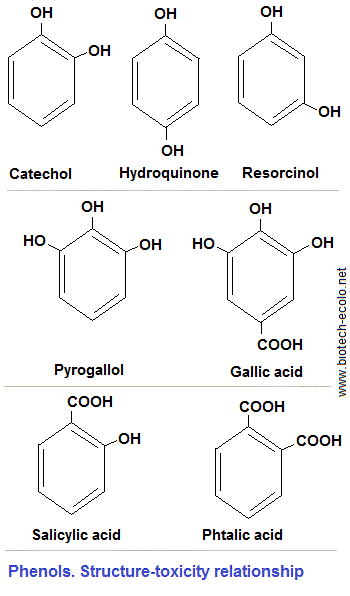

In plant resistance, Unlike to active defense mechanisms that are activated only after pathogen recognition, passive defenses are those that are present before contact with the pathogen.
Passive defense = pre-existing defense (physical barriers, chemical barriers (antipathogenic compounds).
تنتمي دفاعات النبات ضد الممرضات إلى نوعين، منهاالدفاعات التركيبية والخاملة الموجودة سلفًا والدفاعات المستحثة تنتج بعد الإصابة بالعدوى. تعد المناعة البيوكيميائية، ميزة يُفرز من خلالها النبات موادا كيميائية للحد من الأضرار الناجمة عن مسبِّبات الأمراض.. |
Anticipins
Anticipins are different from phytoalexins!
Anticipins are low molecular weight antimicrobial compounds present in plants before challenge by micro-organisms or are produced after infection solely, from pre-existing precursors.
Example of Benzoxazinoids
(BXs):
BXs are widely distributed phytoanticipins among Poaceae. It is commonly
assumed that BX-glucosides are hydrolyzed by plastid-targeted upon tissue
disruption, which results in the release of biocidal aglycone BXs (Morant et al.,2008, beta-Glucosidases as detonators of plant chemical defense. Phytochemistry 69: 1795–1813).
Many investigations have focused on the role of BXs in plant defense
against herbivorous insects and pathogens. The biosynthesis of BXs
is mostly under developmental control and leads to accumulation of
inactive BX-glucosides that are stored in the vacuole.
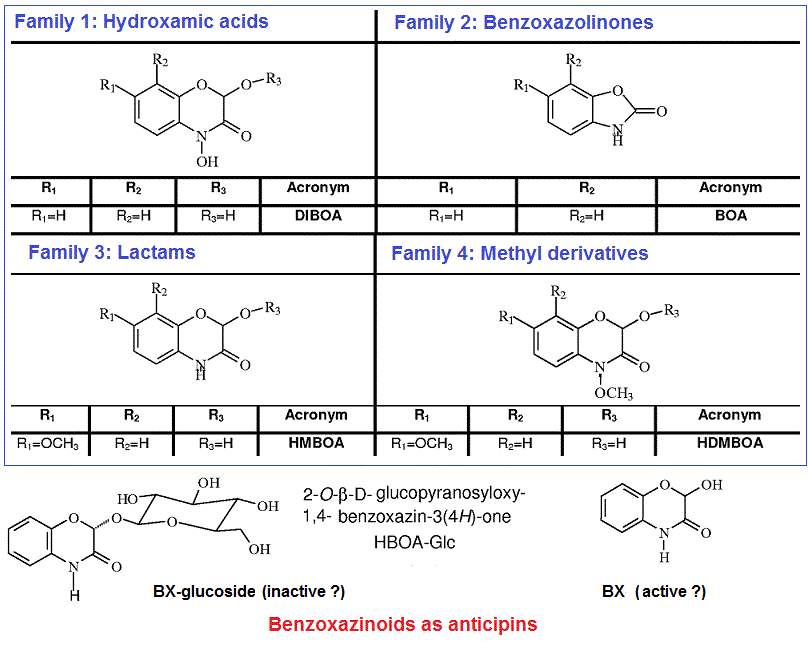
Plant phenolics as passive defenses against fungi
Study 1: Toxic phenols against Verticilium albo-atrum growth (LeTourneau et al. (1957), Phytopathology 47, 602.
Toxicity of phenolics to fungi depends upon their structure
1: Of the three isomeric dihydroxybenzenes (catechol, resorcinol and hydroquinone), catechol, with hydroxyl groups in rhe ortho position, was most growth inhibitory.
- the para isomer of dihydroxybenzene, hydroquinone, reduced the growth considerably, but was not as effective as catechol.
- the meta isomer, resorcinol, had no effect on fungus growth.
2/ Pyrogallol with 3 hydroxyl groups on adjacent carbon atoms, was the most toxic phenolic compound tested.
The addition of a carboxyl group in position 5 of pyrogallol to form gallic acid, greatly decreased its growth inhibition of Verticillium albo-atrum.
3/ The remplacement of the hydroxyl group of catechol to form salicylic acid, greatly reduced its toxicity to Verticillium albo-atrum. Phtalic acid, in which both hydroxyl groups were replaced by carboxyl groups, did not inhibit growth.

Study 2. Relation entre la toxicité des phénols vis à vis des chamignons et leur structure chimique (Rahouti et al. (1997), Actes Inst. Agron. Vet. (Maroc) 17, 165.)
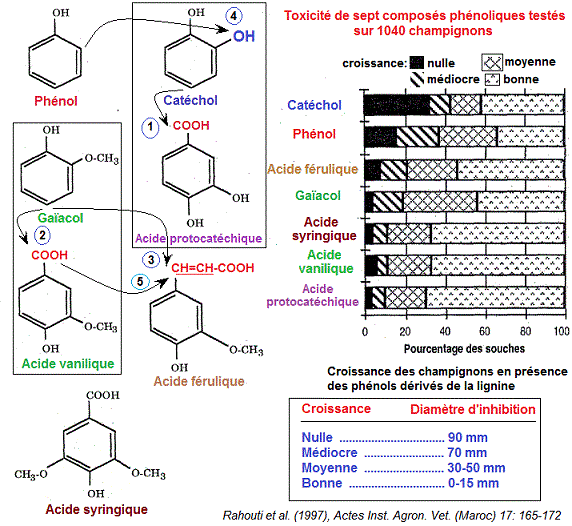
L'effet inhibiteur des phénols sur la croissance des champignons peut diminuer ou augmenter lorsqu'on additionne certains groupements à leurs molécules:
1/ Addition d'un carboxyle sur le cycle benzénique du catéchol produit l'acide protocatéchique, ce qui diminue d'une façon notable la toxicité du catéchol.
2/ Addition d'un carboxyle sur le cycle benzénique du gaïacol produit l'acide vanillique, ce qui diminue d'une façon notable la toxicité du gaïacol.
3/ l'addition au gaïacol d'une chaîne latérale formée par l'acide propénoïque produit l'acide férulique, qui est légèrement plus toxique que le composé de départ.
4/ L'addition d'un hydroxyle en position ortho au phénol (transformation en catéchol) augmente sensiblement sa toxicité.
5/ Après addition à l'acide vanillique
d'un groupement éthylénique entre le noyau aromatique et le carboxyle, on obtient un composé plus toxique, qui est l'acide férulique. Ceci est en accord avec les travaux de Buswell & Eriksson (1994), qui ont rapporté que les acides p-coumarique et férulique
sont beaucoup plus toxiques que les acides benzoïques correspondants,
à savoir les acides p-hydroxybenzoïque et vanillique..
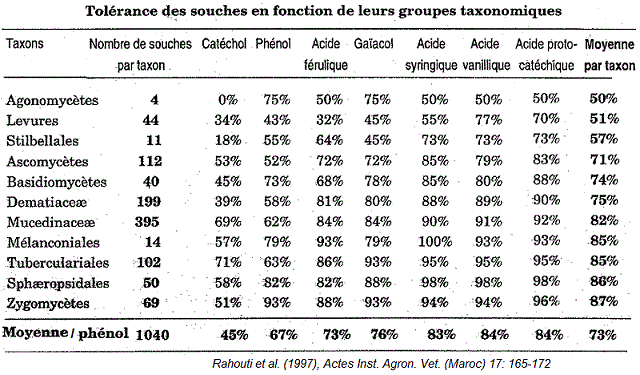
les Zygomycètes, Sphaeropsidales, Tuberculariales et les Mélanconiales sont les groupes qui ont la meilleure tolérance aux 7 phénols, suivis par les Mucedinaceae. Les Dematiaceae, les Basidiomycètes et les Ascomycètes ont une tolérance assez bonne. Les Stilbellales, les levures et les Agonomycètes représentent les groupes les plus sensibles à la toxicité des phénols étudiés.
Est ce que les champignons sont capables de détoxifier les composés phénoliques des plantes?. Effet des enzymes sécrétées par les champignons (phénolase, peroxydase, laccase, ..)?.
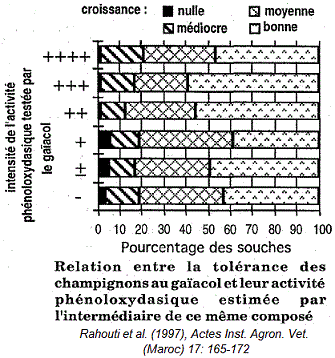
ll résulte de cette étude que les champignons qui ne forment pas les phénoloxydases tolèrent mieux la présence du catéchol et du phénol. La tolérance aux 5 autres phénols ne semble pas être affectée par la présence ou l'absence de ces enzymes.
Cetrain auteurs ont rapporté que l'activité de la laccase augmente la toxicité des phénols. Dans lèur étude sur la fonction de la laccase du champignon de pourriture blanche Fomes annosus, ils ont trouvé que le catéchol et le gaïacol inhibaient fortement la croissance du champignon, lorsque ce dernier produisait une laccase extracellulaire.
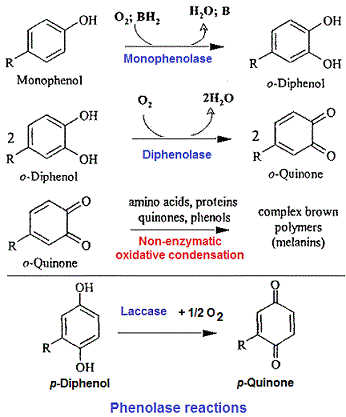




Study 3. Phenolics (preformed) act on fungi through inhibition and inactivation of enzymes produced by pathogens
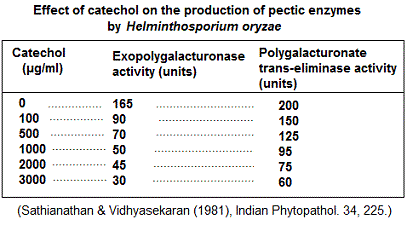
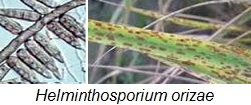
Catechol decreased the production of pectic enzymes, in particular, exopolygalacturonase and polygalacturonase trans-eliminase. by Helminthosporium oryzae, the rice brown spot pathogen.
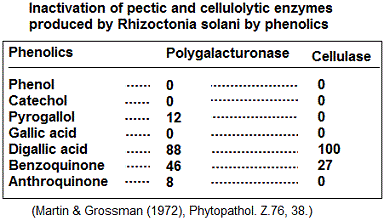
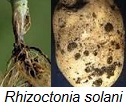
Phenolics inactivate pectolytic and cellulolytic enzymes produced by phatogens. Digallic acid and benzoquinone inactivated polygalacturonase and cellulase produced by Rizoctonia solani while phenol, catechol, pyrogallol, gallic acid and anthroquinone were noninhibitory
Les pectines (substrats des pectinases ou polygalacturonases) sont des hétéropolysaccharides caracterisés par une forte teneur en acide galacturonique (GalA), monomères liés entre eux par des liaisons alpha-(1-4) et partiellement acétylés ou estérifiés par des groupements méthyles. Les pectines sont des substances exclusivement d'origine végétale. Elles sont présentes en grande quantité dans les parois primaires des dicotylédones et en particulier dans les parois végétales de plusieurs légumes et fruits.

Study 4. Phenolics can suppress toxin production by pathogens or detoxify toxins
In plant pathology a toxin is generally defined as a nonenzymic substance which injures plant cells or disrupts their metabolism
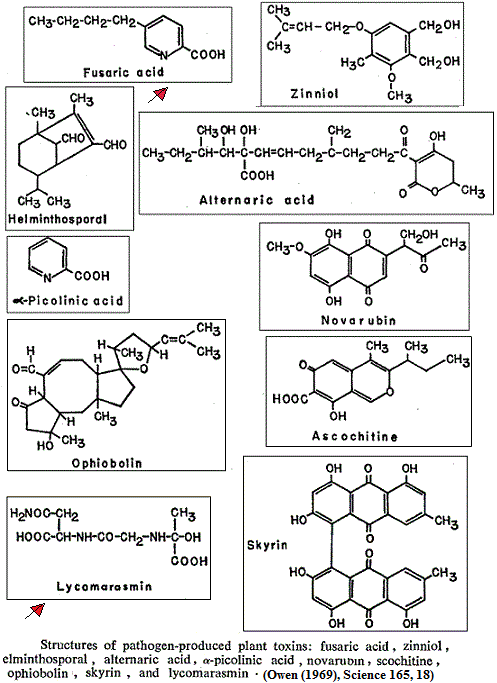
Fusaric acid is produced by cultures of many species of Fusarium and this acid has been detected in tomato and wilted cotton. Fusaric acid forms a weak chelate with metal ions and inhibits rice catalase by forming a complex with its heme-Fe prosthetic group. The inhibition depends upon the presence of the carboxyl group in the fusaric acid molecule and can be reversed by addition of Fe3+. The toxin does not inhibit enzymes lacking bound metals. Fusaric acid also caused electrolyte loss, wilting of tomato cuttings, and changes in cell permeability of rice tissue.
A case of wilt diseases
When cultures of Fusarium oxysporum f.sp. lycopersici (tomato wilt) were grown on yeast extract media containing various catechol concentrations, and the conidia obtained served for the inoculation of tomato and brinjal plants, the conidia from 500 ppm catechol did not induce the wilt in either tomato or brinjal (aubergine, Solanum melongena). This result suggests that the fungus grown in the catechol medium had lost the ability to produce toxins inducing wilt disease (suppression of toxin production)
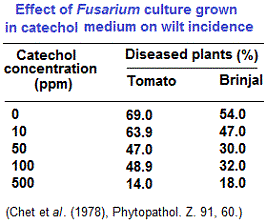


Lycomarasminis a toxin produced by Fusarium oxysporum f. lycopersici. Lycomarasmin causes wilting of tomato cuttings. Its toxicity is increased tenfold by the presence of iron (Fe), with which it forms a weak chelate, but it is detoxified by other metal ions. In the presence of iron, lycomarasmin causes increased transpiration of tomato cuttings.
Plant active defenses against fungi

Links:
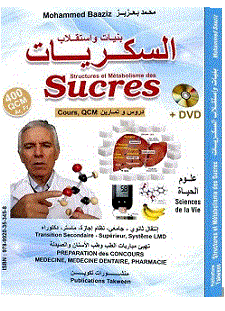
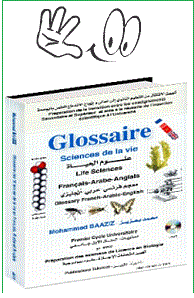

ENSEIGNEMENT DE MASTER
- - Cours du Master Biotechnologies et Amélioration des Plantes, Marrakech
- Travaux pratiques Master Biotechnologies et Amélioration des Plantes, Marrakech